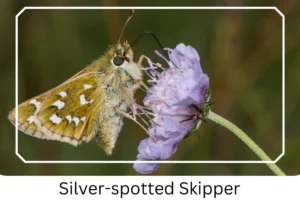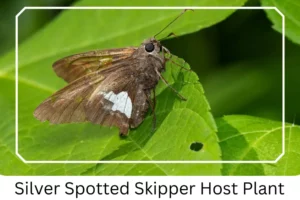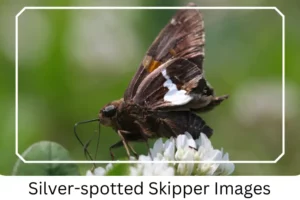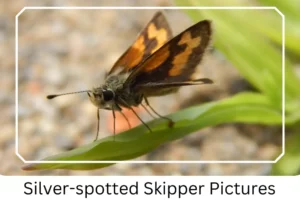Silver-spotted Skipper (Epargyreus clarus)
The Silver-spotted Skipper is a fascinating species of butterfly that belongs to the skipper group, uniquely positioned in the natural world as an intermediary between butterflies and moths. This species has a wide distribution across the United States and extends into parts of neighboring countries, showcasing its adaptability and the ecological role it plays in various habitats.
Scientific Classification
- Family: Hesperiidae
- Genus: Epargyreus
- Scientific Name: Epargyreus clarus
Overview
Characterized by distinct physical features and behaviors, the Silver-spotted Skipper has intrigued scientists and butterfly enthusiasts alike. Its lifecycle, from the larva stage to a full-grown adult, presents a remarkable journey of transformation, adorned with vibrant colors and patterns that serve both aesthetic and functional purposes in their survival.
Description and Identification
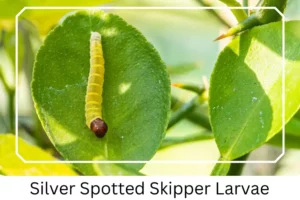
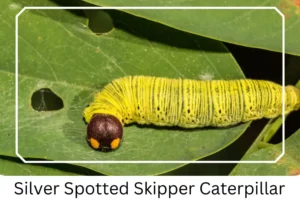 Caterpillar
Caterpillar
The Silver-spotted Skipper caterpillar exhibits a segmented body with alternating peach-orange and beige colors. The head is dark brown to black, with tiny, dark orange legs. As the caterpillar matures, it turns bright yellow, and its head becomes bright red with two yellow spots, mimicking eyes to deter predators. These larvae feed on various woody legumes from their host plants, playing a specific role in the ecosystem.
Pupa
The chrysalis stage shows a transition with a flatter, dull gray-yellow to rusty brown coloration. This camouflage blends seamlessly with the dry or dead leaves of the host plants, providing a natural defense mechanism against predators.
Adult Butterfly
Sexual Dimorphism: This species exhibits sexual dimorphism, where males and females can be distinguished by physical features. Males possess two elongated, black marks on their forewings, absent in females.
Color and Appearance: With wings open, adults display a brownish-black hue adorned with yellow to golden and orange markings. The hindwings of both sexes feature a metallic white band, a distinctive trait when the wings are closed.
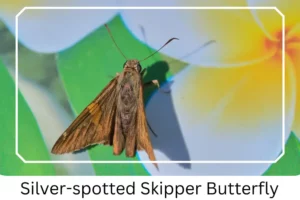
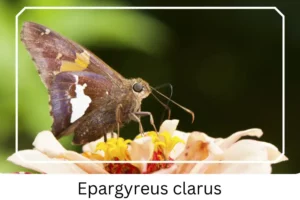 Average Wingspan: The Silver-spotted Skipper boasts an average wingspan of 1.75 to 2.63 inches (4.5 to 6.7 cm), allowing for swift and acrobatic flight patterns.
Average Wingspan: The Silver-spotted Skipper boasts an average wingspan of 1.75 to 2.63 inches (4.5 to 6.7 cm), allowing for swift and acrobatic flight patterns.
Flight Pattern: Known for their rapid and dexterous flying abilities, these butterflies navigate their environments with precision and grace.
Eggs
The eggs are lemon yellow, segmented akin to citrus fruits, and laid individually, showcasing the species’ unique reproductive strategy.
Quick Facts | |
| Distribution | From southern Canada, across most of the US, to northern Mexico, excluding the Great Basin and western Texas. |
| Habitat | Prefers sunny open lands, forest edges, foothill stream courses, fields, prairie waterways, and gardens. |
| Host Plants | Favors black locust, honey locust, and false indigo among others. |
| Adult Diet | Primarily nectar from flowers. |
How to Identify Silver-spotted Skipper?
Identifying a Silver-spotted Skipper can be a rewarding experience for any nature enthusiast. Look for the signature metallic white band on the hindwings, a distinctive marker of this species. The adult butterfly’s brownish-black wings with yellow, golden, and orange accents are noticeable when spread open. Males can be distinguished by the black marks on their forewings. Observing the butterfly’s flight can also provide clues; its swift, acrobatic patterns are characteristic. When spotting eggs, their lemon-yellow color and citrus-fruit-like segmentation are key identifiers. Recognizing these features can enhance your butterfly watching and contribute to understanding their ecological role.
Did You Know?
- The distinctive silver (metallic white) band on the back of the hindwings gives this butterfly its name.
- The larvae are considered pests in some regions, as they feed on various crop plants, including soybeans and kidney beans.
- Interestingly, the Silver-spotted Skipper rarely visits yellow flowers, showing a preference for red, pink, purple, blue, and sometimes white and cream colors.
- This species plays a crucial role in pollination, contributing to the biodiversity and health of ecosystems.
Conclusion
The Silver-spotted Skipper is more than just a beautiful butterfly; it is a key player in its ecosystem, with unique behaviors and characteristics that fascinate scientists and nature lovers alike. By understanding and identifying this species, we can appreciate the intricate balance of nature and the importance of conserving the habitats that support such diverse life forms.

